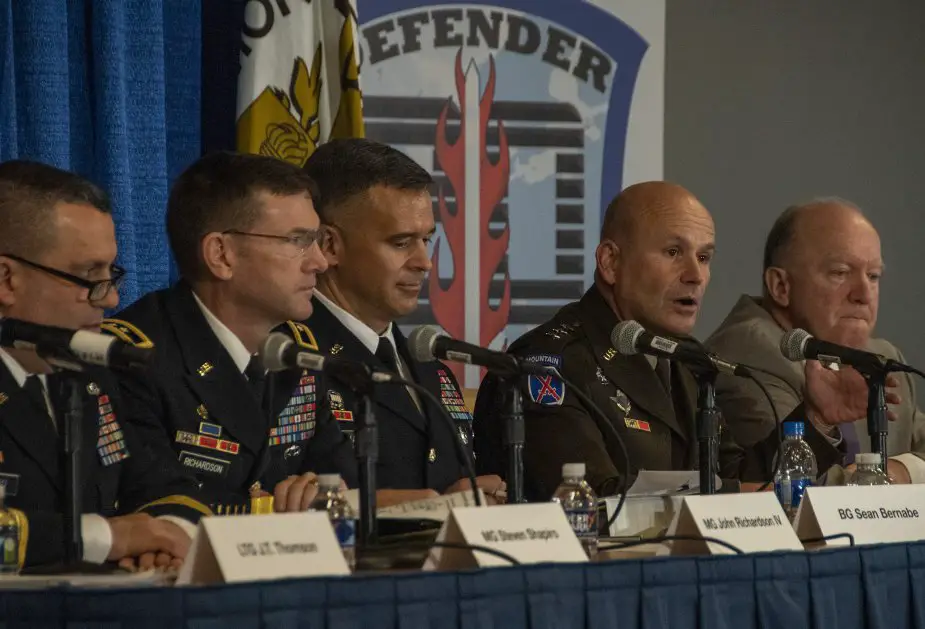Army leaders in Europe revealed details Tuesday, Oct. 15, of a massive exercise that will send 20,000 U.S. soldiers to the continent next spring to conduct force projection and readiness training across ten countries. Defender-Europe 20 is slated to be the largest deployment of U.S.-based Soldiers for an exercise to Europe in 25 years. Sean Kimmons, U.S. Army News Service, reports.

Lt. Gen. Christopher Cavoli, second from right, commander of U.S. Army Europe, speaks during a panel discussion at the Association of the U.S. Army Annual Meeting and Exposition in Washington, D.C., Oct. 15, 2019. (Picture source: U.S. Army / Sean Kimmons)
The milestone Defender actually links several exercises in the region, such as Allied Spirit, Swift Response and a Joint Warfighting Assessment. It is expected to include a total of 37,000 participants and 20,000 pieces of equipment shipped from the U.S., as well as 13,000 pieces drawn from prepositioned stocks.
The exercise kicks off a new Defender series of exercises, which will be conducted in the Pacific on alternate years, to rehearse large movements to both regions. The exercises aim to operationalize the National Defense Strategy, which asserts Russia and China as near-peer adversaries. "We are starting it with a bang," said Lt. Gen. Christopher Cavoli, commander of U.S. Army Europe, during a panel discussion at the Association of the U.S. Army Annual Meeting and Exposition.
After the last U.S. tanks left Germany in 2013 as part of a drawdown, the U.S. Army began nine-month rotations of brigade combat teams to bolster its presence and practice rapidly deploying units to Europe. It also built up prepositioned stocks on the continent to equip incoming units.
In March 2019, an emergency deployment readiness exercise sent an armored unit of over 1,500 soldiers from Fort Hood, Texas, to Europe. In less than two days, the unit was able to fall in on prepositioned stocks and travel to Poland for a live-fire exercise, Cavoli said. "We've been practicing this strategy of power projection for about three to four years now into Europe," he said. "Now it's time to practice it at scale."
Five phases
Defender 20 plans to have U.S. Soldiers from five divisions -- 1st Cavalry, 82nd Airborne, 1st Armored, 1st Infantry and 3rd Infantry -- as well as 11 National Guard states and seven Army Reserve units. It will consist of five phases with several key objectives across Europe.
The first phase includes a reception, staging, onward movement and integration, or RSOI, of a division-sized element while many other units, including a National Guard brigade, will draw prepositioned stocks in Belgium and Germany.
In the second phase, an immediate response force from the 82nd Airborne Division will conduct joint forcible entries into the country of Georgia.
The third phase has a division command post exercise that will have units spread out across the continent. It will also involve a Joint Warfighting Assessment to test multi-domain operations as well as capabilities being pursued by Army Futures Command.
Soldiers will then conduct a river crossing in the fourth phase, as well as forward passage of lines and a maritime prepositioned force off-load mission. The fifth phase will consolidate Army forces and redeploy them.
The exercise will cover 4,000 kilometers of convoy routes and rely on 10 European countries to host exercise activities.
Allies and partners will also get the opportunity to train alongside U.S. soldiers, increasing interoperability within the NATO alliance. "Defender really helps us enhance relationships," said Lt. Gen. J.T. Thomson, commander of Allied Land Command, which oversees NATO land forces. More than half of NATO's member states, he said, will play a role in the exercise. "Cohesive multinational forces give us a competitive advantage, no doubt about it," Thomson said during the panel. "When you look at our adversaries, they do not enjoy the advantages we have and the power of synergy that comes from good, trusted friends."
While there are similarities to the REFORGER exercise, or Return of Forces to Germany, which practiced deploying Army units into Europe during the Cold War, leaders say that Defender will be more complex. "We cannot fail prey to nostalgia of REFORGER and think Defender Europe is just a reincarnation," Thomson said. "Our security environment has changed significantly in terms of geography and borders [and] in terms of allies and partners." Technology and doctrine, he noted, is also different, as well as threats in the region.














